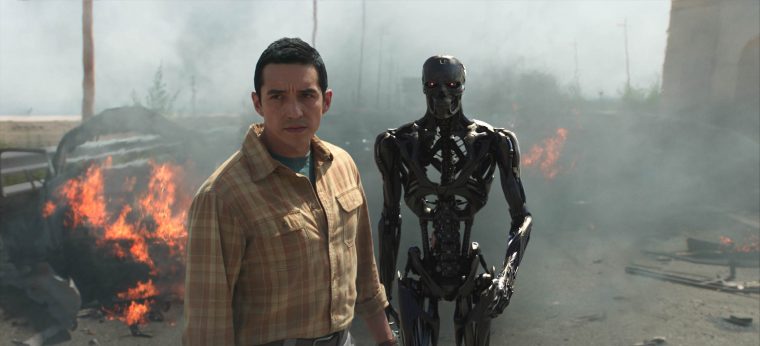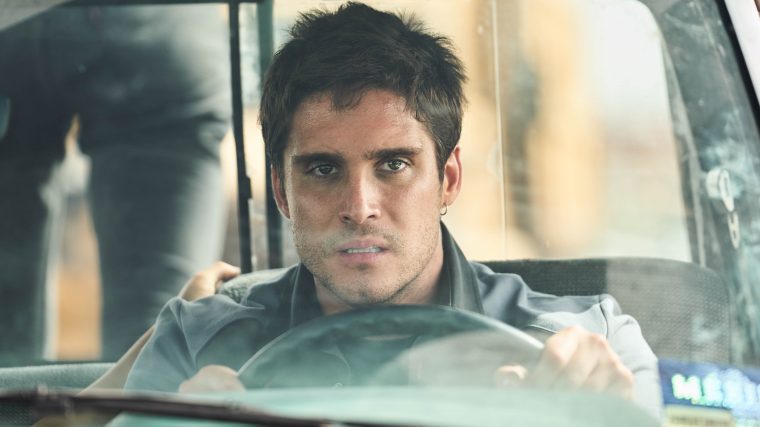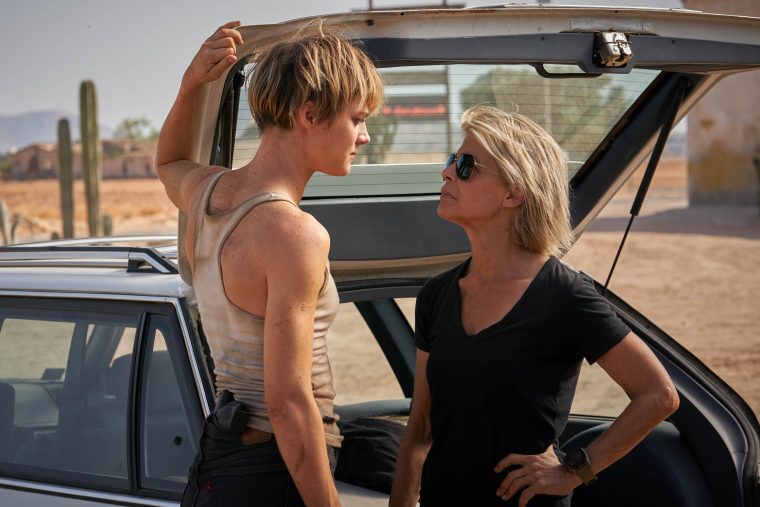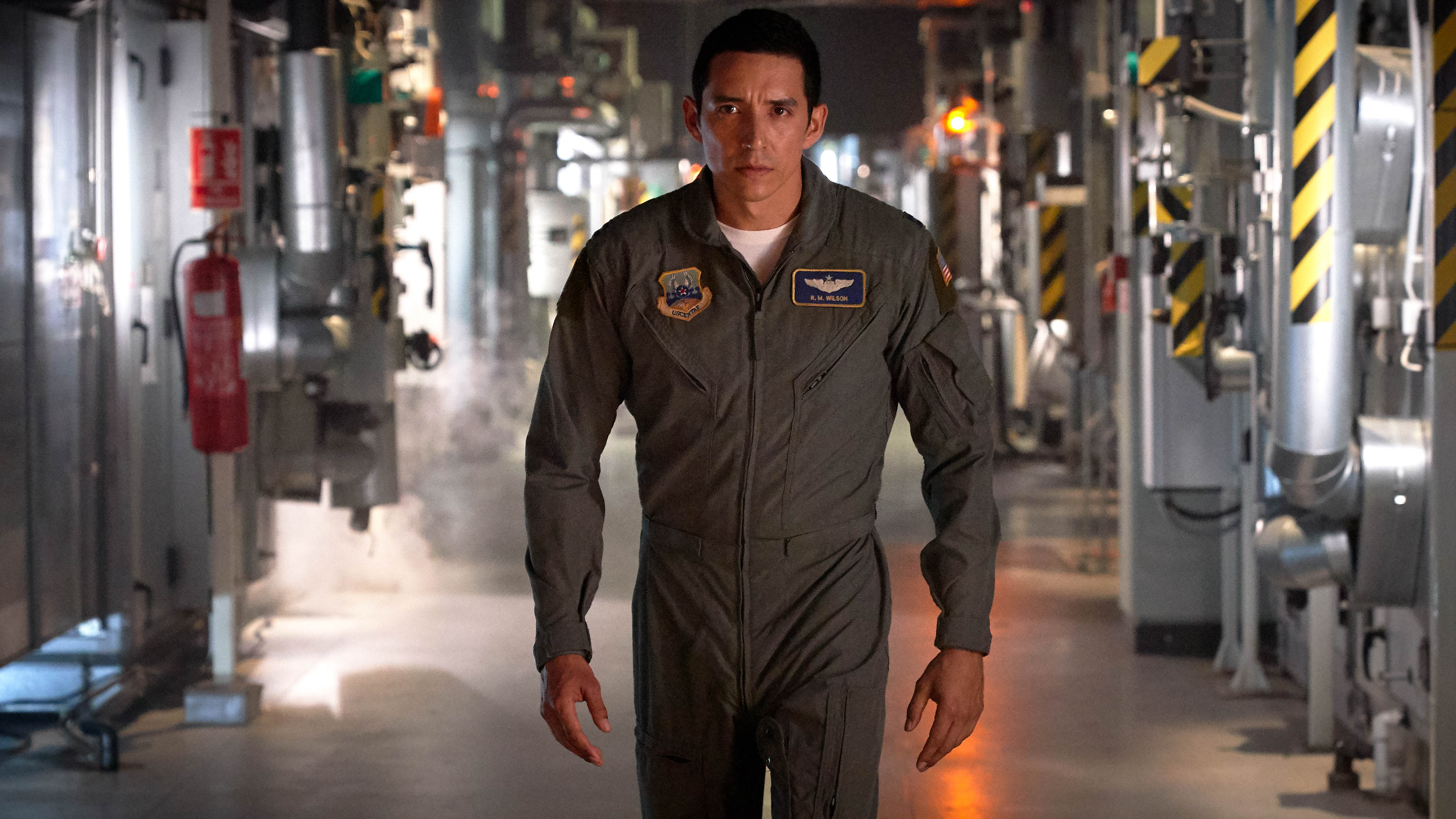The classic sci-fi Terminator franchise has several installments with some of them made after James Cameron’s exit from the director’s chair. The master filmmaker disliked those sequels so much he stepped in to produce a new Terminator movie that rewrites the storyline and ignores those prior versions he wasn’t involved with. Terminator: Dark Fate takes the action to Mexico City and gives us not only a Latin American heroine, but a Latino villain in the form of Gabriel Luna’s performance as a shape-shifting android. (Hats off to the writers for not making the new Mexican-American Terminator utter Arnold Schwarzenegger’s classic line: “Hasta la vista, baby.”)
With this change in setting, it’s vital that Latinos join the conversation about the movie. And since most media outlets don’t employ Latino critics, we gave them the chance to opine on the action-packed movie. Read their reviews below.
Terminator: Dark Fate opens in theaters on November 1, 2019.
— Vanessa Erazo, Remezcla Film Editor

For the last decade I vowed I would never get excited about a Terminator movie again. But when the trailers started dropping for Terminator: Dark Fate I felt something bubbling up. Dare I call it excitement? Director Tim Miller does something wonderful with Dark Fate in that he caters to fans who have followed the series since 1984 with the return of Sarah Connor herself (Linda Hamilton) and Arnold Schwarzenegger’s robot with a heart of gold. But he simultaneously injects the franchise with new blood, anchored by characters of color.
Natalia Reyes’ Dani Ramos is cut from the Sarah Connor cloth to the point that Hamilton has to say “I was her.” The distinction lies in Dani’s unspoken history. She works with her brother in a factory and wants a better life, but that requires putting up with what they’re given. This new fate is meant to give her a purpose, but she resists. She doesn’t want to be used as any type of chip, a pawn in anyone’s game. The script certainly wants us to see the future is female, but it also wants to remind us that the future is made of minorities. Gabriel Luna’s new take on the Terminator is interesting in that he doesn’t imitate or draw upon the previous iterations. He plays the character as knowing he’s not human and only have the barest notion of passing.
I worried that the movie would utilize Mexico’s issues as an attempt to be woke or in the know, and there are certainly valid criticisms. The references to Border Patrol, border crossings, detention centers, even the use of the word “detainee” (which plays like a laugh line because of how the U.S. agent thinks its better than “prisoner”) is a pointed call to arms. Yes, white women still anchor this movie, but the more interesting story is emphasizing how Dani and the new Terminator are playing out a grander game for supremacy that’s more compelling than anything the white characters can conjure up.

Every Terminator film is, in essence, a hunt. In the case of Terminator: Dark Fate, which retcons the many sequels since 1991’s Terminator 2: Judgement Day, the hunt is for Dani Ramos (Natalia Reyes). This lends the movies a propulsive narrative engine: every action sequence is a chase or a standoff, and sometimes both at the same time. Beat by beat, Dark Fate is a quintessential Terminator film. There’s the hunt, yes, courtesy this time of a Latino Terminator in the hands of Austin native Gabriel Luna. And there’s the familiar faces, what with both Linda Hamilton in full gruff badass mode as Sarah Connor and the OG Terminator himself Arnold Schwarzenegger mining his deadpan delivery for all its worth, reuniting for the first time since 1991. Following the laws of sequels Dark Fate aims for both “the same, but MORE!” and “the same, but slightly different.” Its action sequences — on busy freeways and in an ICE detention center, or on a military airplane while midflight and in a roaring dam — are designed to up the stakes for all those involved, which this time around also includes an enhanced human from the future, a cyborg called Grace (Mackenzie Davis). Director Tim Miller matches OG director James Cameron when it comes to ambition, but less so when it comes to execution. With his penchant for slow-mo zooms and a frenetic editing style that believes one builds tension via disorientation, his set pieces get increasingly spastic.
It’s in the tweaks to the franchise’s storytelling that Dark Fate delivers its most inspired creations. Here is a blockbuster that centers on a young Mexican woman who has to cross the border illegally in order to keep herself alive. The film’s nods to her plight, including a scene set on ‘La Bestia’ train, gesture toward fascinating ways of rewriting the Terminator lore. But Miller and his writers use that more as scenery than anything else. Moreover, while Dark Fate wants to pat itself on the back when it comes to such representation, well-tuned ears will notice that Reyes’s Colombian accent remains intact; that background actors in “Mexico City” (it was shot in Spain) sound very unconvincing; and that the script’s truncated reason for why Dani and her brother (Diego Boneta) speak to one another in English borders on laughable. Rife with provocative ideas and new characters, Dark Fate is as serviceable a Terminator sequel as one could ask for in 2019, for better and for worse.

Murderous robots and time-traveling humans manifest in the streets of Mexico City for Terminator: Dark Fate, a border-crossing sequel to the decadeslong post-apocalyptic saga that’s somewhat radical for an installment of a profitable franchise. For once a Latina’s life is invaluable to the white characters in a studio production, and the future of our species depends on her survival. That alone makes it noteworthy.
Jaw-dropping set pieces and amalgamations of top-notch stunts and digital effects revolve around Dani Ramos, who’s embodied with commanding heroism despite trite lines of dialogue by Colombian rising star Natalia Reyes (Birds of Passage). A factory worker, she discovers she is the target of a futuristic killing machine. The far-fetched notion that a working class person in the Mexican capital is completely fluent in English emerges during the first act — probably out of the filmmaker’s fear of alienating certain audiences with too many subtitles or perhaps just lack of care for representing this population. Luckily, her brother, a beefed up and tan Diego Boneta (Luis Miguel: The Series), throws in Mexican slang and a song to counteract the contrived language choices.
Having this reinvented iteration of the timeless Terminator played by Mexican-American actor Gabriel Luna (Marvel’s Agents of S.H.I.E.L.D.) wearing a Border Patrol uniform as he chases a Mexican woman who entered the U.S. without documents, points to the writers’ (none of whom are Latino) interest in grappling with current headlines, but ultimately the intentions are vague. Conveniently for the plot and stereotypical for such a character, Dani just happens to have an uncle who works as a coyote, and she, a woman with a stable job and promising future, is casually unfazed by the prospect of riding ‘La Bestia,’ as if this was a common experience for anyone living south of the border.
Notwithstanding the writing pitfalls it fails to avoid, like its awkward humor, Tim Miller’s Dark Fate ventures into murky waters when it comes to Latino representation. It has a bit more cultural sensitivity than other Mexico-set Hollywood productions like the Sicario films or the most recent Rambo debacle, but not enough to earn high marks. Still, seeing Reyes front and center in the middle of a chaotic climax and calling the villain a “cabrón” signals an opening on the part of Hollywood’s gatekeepers to move toward storytelling that includes Latinos in roles beyond victimization.

Terminator: Dark Fate has its issues, namely in trying to figure out how to represent today’s empowered woman, but one of the things that Dark Fate gets right, that so many other films have failed at, is how it treats its Latinx characters. For one, this type of story — a world-building blockbuster franchise — rarely includes Latinx actors. When they are lucky enough to land a role, Latino characters usually have a sad or tragic immigration narrative (HBO’s The Icebox) or are minor characters with no story arc (Ana de Armas’ role in Blade Runner 2049) — just there so the filmmakers can pat themselves on the back and claim that they believe in representation. In the worst cases, Latinos remain regulated to playing stereotypes: maids, drug dealers, and gang members. Dark Fate not only gives us a Latino Terminator, but a Latina heroine who doesn’t have a tragic back story, and who isn’t a maid or an unwed mother. Dani Ramos is allowed to be an everyday Mexican woman who learns of her destiny: the future of humanity rests on her shoulders.
The respect Dark Fate gives its Latinx characters allows the film to unfold organically without being preachy or having blatant political messages. There are subtleties that the viewer will catch if paying attention. These are most apparent during the sequence at the U.S.-Mexico border where specific moments — such as Grace (Mackenzie Davis) glaring at a Border Patrol agent as they mutter “They aren’t prisoners; they’re detainees” or Dani telling a black female Border Patrol guard, “You aren’t safe either” — help shape the narrative around the Latino cast. Dani, and all the Latinx characters including the new Terminator, never have to define their culture by wearing a stereotypical sombrero or having an overly emphasized accent, which is something other filmmakers should pay attention to. In the end, Dark Fate is a Terminator movie, through and through. It’s action packed, fun, thrilling, and that’s exactly what makes the Latino characters thrive — they can just exist and have a plotline that doesn’t consist of defining their Latinidad.
— Yolanda Machado

Terminator: Dark Fate is in many ways the most conventional of Terminator films since 1991’s Judgment Day. This is a good thing: the sequels that followed that James Cameron classic made humanity wish for extinction before another offering. But Cameron’s vow to “be back” is fulfilled in director Tim Miller’s (Deadpool) vision of a future for his franchise. Cameron outlines a story that resembles the original. A Terminator (played by Mexican-American actor Gabriel Luna) arrives from the future to vanquish an unsuspecting Mexican woman Dani Ramos (Colombian actress Natalia Reyes), while another machine-like being, Grace (Mackenzie Davis), shows up to stop the slaughter. Along the way, they encounter Sarah Connor (Linda Hamilton, now aged but more badass than ever), and her lifelong foil, a Terminator originally sent by Skynet and played by an equally grown Arnold Schwarzenegger. Miller’s arresting visual style, which combines sharp colors in hues ranging from darkest night to clear as day, mixes with fast-paced and exhilarating effects to produce a sequel of a 1984 original for a 2019 audience.
In other ways, Dark Fate is far from orthodox, and in those twists, too, it achieves mixed results. The Terminator, it turns out, shows up not in Los Angeles, but in Mexico City. It’s this location that creates the biggest deviation from the original: The heroine and other important characters are not exclusively white, but include Latino and Latin American stars from across the continent. There is subtle political commentary to go along with the innovative casting in that Cameron’s story bemoans the inevitability of cybernetic takeover while being acutely aware of the sociopolitical context. Dani’s quest relies on fleeing the killer robot by crossing the border and without needing a white savior but to take matters into her own hands. She and her brother (Diego Boneta) are hardworking factory hands. None of this plays into Hollywood’s most egregious stereotypes about Latinos. But while Dark Fate’s strides are welcome, shortcomings are still clear around the edges. The script does not fully commit the Mexican characters to speaking Spanish in Mexico, and many will notice that Natalia Reyes speaks with a Colombian accent. Still, Dark Fate (mostly) makes good use of its Latinx stars. For Latinos hoping for improved representation in Hollywood, this Terminator installment is an important step — just like the franchise was for Sarah Connor and now, Dani Ramos — on a longer journey to salvation.

Since Hollywood is in the business of exhuming franchises with preexisting fan bases for a quick buck, Terminator: Dark Fate should come as no surprise. Despite the promise of a diverse cast fronted by girl power of all ages, this latest reboot struggles to engage with these novel elements in a meaningful way. Too obvious are the stitches of this narrative cobbled together in the name of franchise aspirations — a shame, considering how well the cast clicks. Tim Miller of Deadpool directs, which in part explains the film’s mediocrity. Miller is essentially a minion, a beneficiary of the studios as they continue to stake out obedient and bland filmmakers to spearhead their multimillion dollar IP efforts. But what about the establishment of an ass-kicking Latina as the main character in the inevitable spin offs? It’s a question audiences may contemplate, but the threat of these inevitable spin offs is precisely why Dark Fate, however much it satisfyingly centers Latino characters and a novel Mexican setting, feels inauthentic in its interest of either of these things.
Dani Ramos (Natalia Reyes) is the target of the new Terminator (Gabriel Luna), sent from the future along with Grace (Mackenzie Davis), a robotically enhanced human meant to serve as Dani’s protector. A quintessential Terminator entry, the film comprises one long chase punctuated by moments of group tension, going from a high-speed highway faceoff, to a detention center breakout, to an airborne melee and so on. Throw in the take-no-shit attitude of Sarah Connor (Linda Hamilton), and the original deadpan Terminator (Schwarzenegger) for extra muscle and comic relief. Yet Dark Fate is never genuinely interested in Dani, its true protagonist. We know she speaks fluent English, that she’s her family’s matriarch, she works in a factory and her uncle is a coyote — which seems to me an awful lot like plot-motivated characterization by the design of clumsy and contradictory racial generalizations. And while the film’s second half is compelling in its tense (if visually muted) nighttime air, land, and sea fight sequences, make no mistake: its embrace of Mexico and border issues is, at best, a politically opportune change of scenery. Dark Fate remains frustratingly surface level: diversity? Check. Fan service? Check. Sowing the seeds for the sequel? Check. And in mechanically ticking all the boxes, the actioner betrays its own half-enthusiasm for everything it sets out to do.




